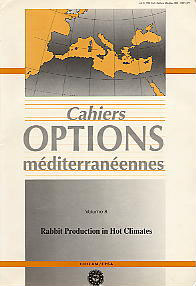| Article précédent | p. 169-175 | Article suivant |
The use of dried pigeon dropping in rabbit nutrition
Forty New Zealand White rabbits, five weeks old, were allocated equally to four groups and kept individually in cages. The rations were isocaloric isonitrogenous containing varying levels of dried pigeon droppings (0, 6, 12 and 18 per cent). Also, the dietary fibre levels were similar among the groups. The trial lasted for a period of ten weeks. Body gain, feed intake and feed conversion ratio were affected by using DPD containing rations. Growth rate decreased while feed intake increased by increasing its level of inclusion. Feed conversion decreased by increasing DPD levels especially groups given 12 per cent and 18 per cent DPD rations. Dressing percentage of rabbits fed on DPD containing rations was insignificantly lower than that of the control ration (not significant). The economic efficiency of 6 per cent and 12 per cent DPD containing rations was similar to that of the control ration. The 18 per cent DPD ration had lower economic efficiency which was about 50 per cent of the control ration. It can be concluded that DPD can be used up to the rate of 12 per cent with satisfactory results and with no adverse effect on body gain, feed conversion and economic efficiency.
- [ Afficher ]
- [ Télécharger ]
- [ Exporter la citation ]
Vous pouvez télécharger la citation au format :
- [ Imprimer ]
-
Mots-clés
ALIMENTATION DES ANIMAUX, CARCASSE, COMPLEMENTATION, CROISSANCE, EFFICACITE ALIMENTAIRE, FUMIER, LAPIN, RENTABILITECiter cet article
Nokhtar S.M., Radwan M.S., Essmat M.O., Mahmoud M.M.A., Abdel-Hameed M.S. The use of dried pigeon dropping in rabbit nutrition. In : Baselga M. (ed.), Marai I.F.M. (ed.). Rabbit production in hot climates. Zaragoza : CIHEAM, 1994. p. 169-175. (Cahiers Options Méditerranéennes; n. 8). 1. International Conference of rabbit production in hot climates, 1994/09/06-08, Cairo (Egypt). http://om.ciheam.org/om/pdf/c08/95605290.pdf



